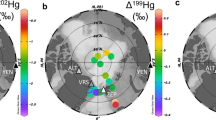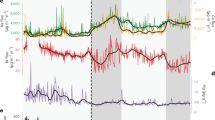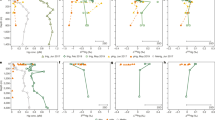Abstract
Mercury is a potent neurotoxin, which enters remote ecosystemsprimarily through atmospheric deposition1,2. In the polar atmosphere, gaseous elemental mercury is oxidized to a highly reactive form of mercury, which is rapidly removed from the atmosphere by deposition3,4. These atmospheric mercury-depletion events are caused by reactive halogens, such as bromine, which are released from sea-ice surfaces5,6. Reactive halogens also exist at temperate and low latitudes7,8, but their influence on mercury in the atmosphere outside polar regions has remained uncertain. Here we show that bromine can oxidize gaseous elemental mercury at mid-latitudes, using measurements of atmospheric mercury, bromine oxide and other trace gases over the Dead Sea, Israel. We observed some of the highest concentrations of reactive mercury measured in the Earth’s atmosphere. Peaks in reactive mercury concentrations coincided with the near-complete depletion of elemental mercury, suggesting that elemental mercury was the source. The production of reactive mercury generally coincided with high concentrations of bromine oxide, but was also apparent at low levels of bromine oxide, and was observed at temperatures of up to 45 °C. Using a chemical box model, we show that bromine species were the primary oxidants of elemental mercury over the Dead Sea. We suggest that bromine-induced mercury oxidation may be an important source of mercury to the world’s oceans.
This is a preview of subscription content, access via your institution
Access options
Subscribe to this journal
Receive 12 print issues and online access
$259.00 per year
only $21.58 per issue
Buy this article
- Purchase on Springer Link
- Instant access to full article PDF
Prices may be subject to local taxes which are calculated during checkout




Similar content being viewed by others
References
Fitzgerald, W. F., Engstrom, D. R., Mason, R. P. & Nater, E. A. The case for atmospheric mercury contamination in remote areas. Environ. Sci. Technol. 32, 1–7 (1998).
Mason, R. P. & Sheu, G-R. Role of the ocean in the global mercury cycle. Global Biogeochem. Cycles 16, 1093 (2002).
Schroeder, W. H. et al. Arctic springtime depletion of mercury. Nature 394, 331–332 (1998).
Steffen, A. et al. A synthesis of atmospheric mercury depletion event chemistry in the atmosphere and snow. Atmos. Chem. Phys. 8, 1445–1482 (2008).
McConnell, J. C. et al. Photochemical bromine production implicated in Arctic boundary-layer ozone depletion. Nature 355, 150–152 (1992).
Fan, S-M. & Jacob, D. J. Surface ozone depletion in Arctic spring sustained by bromine reactions on aerosols. Nature 359, 522–524 (1992).
Hebestreit, K. et al. DOAS measurements of tropospheric bromine oxide in mid-latitudes. Science 283, 55–57 (1999).
Matveev, V. et al. Bromine oxide–ozone interaction over the Dead Sea. J. Geophys. Res. Atmos. 106, 10375–10387 (2001).
Lu, J. Y. et al. Magnification of atmospheric mercury deposition to polar regions in springtime: The link to tropospheric ozone depletion chemistry. Geophys. Res. Lett. 28, 3219–3222 (2001).
Lindberg, S. E. et al. Formation of reactive gaseous mercury in the arctic: Evidence of oxidation of Hg° to gas-phase Hg-II compounds after arctic sunrise. Water Air Soil Pollut. 1, 295–302 (2001).
Ariya, P. A. et al. The arctic: A sink for mercury. Tellus Ser. B-Chem. Phys. Meteorol. 56, 397–403 (2004).
Skov, H. et al. Fate of elemental mercury in the Arctic during atmospheric mercury depletion episodes and the load of atmospheric mercury to the Arctic. Environ. Sci. Technol. 38, 2373–2382 (2004).
Brooks, S. B. et al. The mass balance of mercury in the springtime arctic environment. Geophys. Res. Lett. 33, L13812 (2006).
Bottenheim, J. W., Gallant, A. G. & Brice, K. A. Measurements of NOy species and O3 at 82-degrees N latitude. Geophys. Res. Lett. 13, 113–116 (1986).
Saiz-Lopez, A., Plane, J. M. C. & Shillito, J. A. Bromine oxide in the mid-latitude marine boundary layer. Geophys. Res. Lett. 31, L03111 (2004).
Read, K. A. et al. Extensive halogen-mediated ozone destruction over the tropical Atlantic Ocean. Nature 453, 1232–1235 (2008).
Tas, E. et al. Frequency and extent of bromine oxide formation over the Dead Sea. J. Geophys. Res. Atmos. 110, D11304 (2005).
Vogt, R., Crutzen, P. J. & Sander, R. A mechanism for halogen release from sea-salt aerosol in the remote marine boundary layer. Nature 383, 327–330 (1996).
Tas, E. et al. Measurement-based modeling of bromine chemistry in the boundary layer: 1. Bromine chemistry at the Dead Sea. Atmos. Chem. Phys. 6, 5589–5604 (2006).
Sander, R., Kerkweg, A., Jockel, P. & Lelieveld, J. Technical note: The new comprehensive atmospheric chemistry module MECCA. Atmos. Chem. Phys. 5, 445–450 (2005).
Zingler, J. & Platt, U. Iodine oxide in the Dead Sea Valley: Evidence for inorganic sources of boundary layer IO. J. Geophys. Res. Atmos. 110, D07307 (2005).
Holmes, C. D., Jacob, D. J., Mason, R. P. & Jaffe, D. A. Sources and deposition of reactive gaseous mercury in the marine atmosphere. Atmos. Environ. 43, 2278–2285 (2009).
Faïn, X. et al. High levels of reactive gaseous mercury observed at a high elevation research laboratory in the Rocky Mountains. Atmos. Chem. Phys. 9, 8049–8060 (2009).
Goodsite, M. E. & Plane, J. M. C. A theoretical study of the oxidation of Hg° to HgBr2 in the troposphere. Environ. Sci. Technol. 38, 1772–1776 (2004).
Sander, R. et al. Inorganic bromine in the marine boundary layer: A critical review. Atmos. Chem. Phys. 3, 1301–1336 (2003).
Lee, J. D. et al. Reactive halogens in the marine boundary layer (RHaMBLe): The tropical North Atlantic experiments. Atmos. Chem. Phys. 10, 1031–1055 (2010).
Peleg, M. et al. Mercury depletion events in the troposphere in mid-latitudes at the Dead Sea, Israel. Environ. Sci. Technol. 41, 7280–7285 (2007).
Sprovieri, F., Pirrone, N., Garfield, K. & Sommar, J. Mercury speciation in the marine boundary layer along a 6,000 km cruise path around the Mediterranean Sea. Atmos. Environ. 37, 563–571 (2003).
Laurier, F. J. G., Mason, R. P., Whalin, L. & Kato, S. Reactive gaseous mercury formation in the North Pacific Ocean’s marine boundary layer: A potential role of halogen chemistry. J. Geophys. Res. Atmos. 108, 4529 (2003).
Malcolm, E. G., Keeler, G. J. & Landis, M. S. The effects of the coastal environment on the atmospheric mercury cycle. J. Geophys. Res. Atmos. 108, 4357 (2003).
Sunderland, E. M. et al. Mercury sources, distribution, and bioavailability in the North Pacific Ocean: Insights from data and models. Glob. Biogeochem. Cycles 23, GB2010 (2009).
Sunderland, E. M. Mercury exposure from domestic and imported estuarine and marine fish in the US seafood market. Environ. Health Perspect. 115, 235–242 (2007).
Acknowledgements
We thank R. Kreidberg for editorial assistance; the Dead Sea Works for site logistics; J. Zingler, J. Lenvant and U. Corsmeier for meteorological data; R. Sander for use of the MECCA model; L. Wable for graphical support and J. A. Arnone, S. Lindberg and J. McConnell for critical reviews on an earlier manuscript. The study was funded by the US National Science Foundation (no 0813690 to D.O. and M.L.), and has benefited from a US Environmental Protection Agency Star-to-Achieve grant (R833378).
Author information
Authors and Affiliations
Contributions
D.O. and M.L. led the study, including proposal writing, project coordination, data interpretation and manuscript preparation; D.O., M.P., V.M., X.F. and D.A. were directly involved with field measurements at the Dead Sea, data collection and data analysis; E.T. carried out modelling and interpretation of these results. All authors discussed the results and contributed to the manuscript.
Corresponding author
Ethics declarations
Competing interests
The authors declare no competing financial interests.
Supplementary information
Supplementary Information
Supplementary Information (PDF 803 kb)
Rights and permissions
About this article
Cite this article
Obrist, D., Tas, E., Peleg, M. et al. Bromine-induced oxidation of mercury in the mid-latitude atmosphere. Nature Geosci 4, 22–26 (2011). https://doi.org/10.1038/ngeo1018
Received:
Accepted:
Published:
Issue Date:
DOI: https://doi.org/10.1038/ngeo1018
This article is cited by
-
Concentration and speciation of mercury in atmospheric particulates in the Wuda coal fire area, Inner Mongolia, China
Environmental Science and Pollution Research (2022)
-
Concentration, spatiotemporal distribution, and sources of mercury in Mt. Yulong, a remote site in southeastern Tibetan Plateau
Environmental Science and Pollution Research (2019)
-
Air Contamination by Mercury, Emissions and Transformations—a Review
Water, Air, & Soil Pollution (2017)
-
A review of atmospheric mercury emissions, pollution and control in China
Frontiers of Environmental Science & Engineering (2014)
-
Kinetic and Product Studies of the Reactions of NO2, with Hg0 in the Gas Phase in the Presence of Titania Micro-Particle Surfaces
Water, Air, & Soil Pollution (2012)



